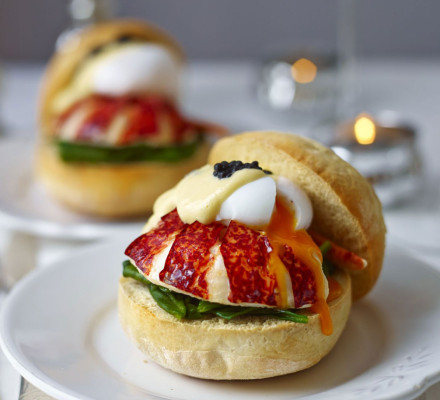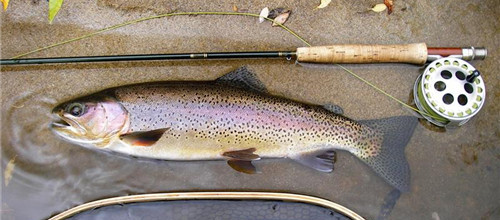
On Food and Wine Pairing
“In Europe we thought of wine as something as healthy and normal as food and also a great giver of happiness and well-being and delight. Drinking wine was not a snobbism nor a sign of sophistication or a cult; it was as natural as eating and to me as necessary.”
― Ernest Hemingway, A Moveable Feast, 1964
The earliest evidence of wine making was discovered in Georgia and dated to 6,000 years BCE, there is also evidence of wine production in Iran 5,000 years BCE, Greece 4,500 years BCE and the oldest known winery was found in Armenia and dates back to 4,100 years BCE. To these civilizations wine was a gift from the gods, the Ancient Greeks worshipped Dionysus as the god of wine, in Rome he was known as Bacchus, effectively the same deity. In Catholicism and other Christian religions wine forms an essential part of the Eucharist, it represents the blood of Christ.
Wine has also been associated with good health since the time of the Ancients and we know through archeological and documentary evidence that wine has been part of the dining experience since the earliest days of its creation; it was seen as a medicine for the body’s well-being, a tonic to aid digestion and a nepenthe for the mind and soul.
One of the most outstanding figures in the history of medicine is the Greek physician Hippocrates; such is the measure of his influence to this very day physicians take the Hippocratic Oath, requiring them to swear to uphold certain ethical standards of medical practice.
Hippocrates advocated and documented using wine as a treatment for many ailments and even experimented with different wines to treat different illnesses. He would also use wine as a disinfectant to wash wounds and as a medium for mixing with herbs to create medicines. For Hippocrates, wine was a preferred beverage in so many instances, simply because it was often more sanitary and reliable than the local water. Hippocrates considered wine a vital food group, part of a healthy diet as important at the table as the food itself.
Given the practical difficulties associated with long distance travel in the days of the Ancient Greeks and the Roman Empire, many of the early food and wine pairings renowned today as classics, were simply regional combinations discovered and enjoyed by expanding empires. The food and the wine from a particular region would become part of the tales travellers would recall upon returning home. Italians rarely dine without wine and as the Roman Empire spread so did the reputation for certain wines and certain dishes from various parts of Europe and beyond. Many of these food and wine combinations had already been regional pairings for centuries, it is perhaps little wonder that in a sort of gastro-Darwinian evolution, certain foods and wines had, over time evolved or been adjusted to become perfectly suited to each other.
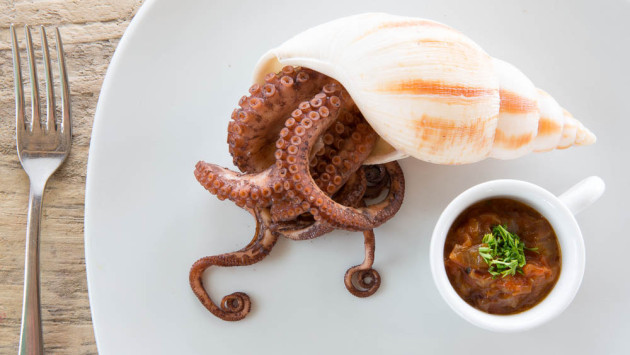
As wine became a sought after commodity with traders, merchants and the wealthier classes, it was soon being shipped around the world, the pairings becoming more adventurous, matched with foods at the point of consumption instead of regional foods at the point of fermentation. A certain set of guidelines or rules soon evolved; they were perhaps a bit of a wine game, designed to reinforce the status of the elite classes who needed to ensure staff knew and followed the rules to affirm their own status and to spare any blushes at table amongst one’s peers.
Rules such as white wine for white meat and red wine for red meat for example were common and what probably started out as friendly advice, eventually became something of an elitist culinary law.
As civilizations began to explore further and further east, out through the Silk Road into the Seven Seas, establishing the spice routes and sharing more ingredients, cuisine began to become more sophisticated in the kitchens of the ruling classes and their courts. The skills and knowledge required by the kitchen and cellar staff in the traditional wine markets were evolving and becoming more complex.
The two ‘Great Exchanges’ of human civilization occurred with the travels of Marco Polo, (1254–1324) into the Far East and Christopher Columbus, (1451-1506) in his epic travels throughout the Americas. These voyages saw the beginnings of the greatest exchanges of cultures, religions, humanity, foodstuffs, material goods and diseases that man had ever known; our kitchens would never be the same again.
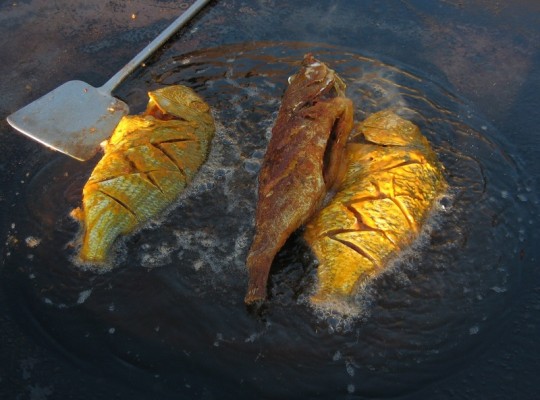
The rise (and eventual fall) of the European empires, notably the Spanish, French and Dutch and English, into the four corners of the world, put humanity on a path towards globalization from which is has never really deviated, especially once the priorities became those of trade over dominion. Migration from the devastation of war has played a significant role in our culinary diversity, as has economic growth in developing countries. Today, someone in Australia is just as likely to cook their dinner in a wok as they are a frying pan and someone in Japan is just as likely to be having Spaghetti Bolognese for dinner as they are sashimi; the national dish of the English is now a curry and you can buy a McDonald’s Hamburger on a street corner in Beijing.
Winemaking has also been growing, changing and spreading out around the world for hundreds of years, today the options are almost too numerous to mention. Many of the old rules and mantras about paring wine with food look quaint, obscure and outdated in a new Millennium full of interconnectedness, openness, exchange and adventure; where being told not to try something is usually good enough reason alone to give it a go and see how it feels to you.
The best food and wine pairing you will ever have in your life is not the one you read in a book or that someone else said you needed to try; the best food and wine experience will always be the one that you enjoyed the most, whether you question why or not doesn’t really matter -that is ultimately up to you.
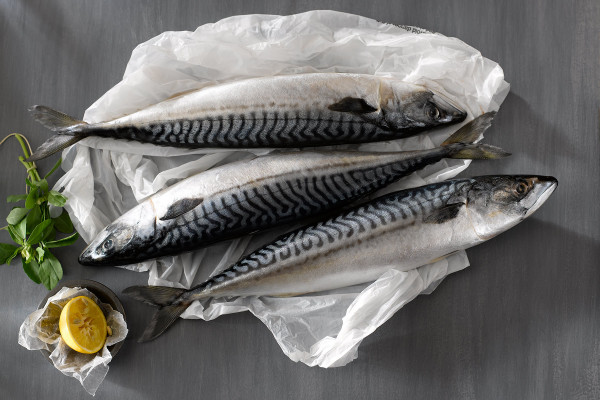
Sommeliers are the new pop stars of the hospitality world, once solely the domain of the celebrity chef, Sommeliers, (or somms if you want to sound super cool) are the subject of movies, documentaries and television shows, fodder for magazines and darlings of social media.
A sommelier is essentially someone who looks after the wine related business in the restaurant, from deciding which wines to buy and put on the wine list, which wines go with which dishes and how wines are to be presented and served to guests.
Sommeliers consider themselves experts on all matters to do with wine and a great many of them are indeed just that. They work very hard at it, acquiring knowledge and skills, they are obsessively passionate about their work and they can be very helpful when trying to select a wine to have with your meal or to pair to a dish. Sommeliers have to walk a very fine line and never cross it; a sommelier should never be arrogant, should never act with an air of superiority and should always listen to their guests, for it is the guest’s desires they must try to serve and please and not serve their personal interests or tastes.
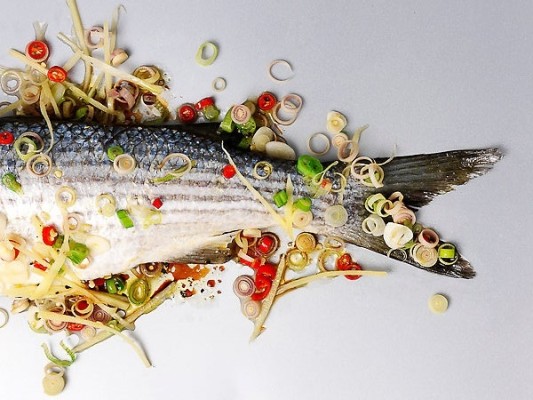
A challenge to pairing certain wines to certain dishes is the challenge of changing consumption habits. We tend to eat out and in groups more often and we tend to order our own food but share the wine. This means for example; what might be a perfect wine for me and my steak may not be a good match for my friend and her fish. More and more and as is traditional in many countries throughout East and South East Asia, we eat many dishes all at one time banquet style and a wine that may suit one of the dishes on the table may not suit the other five or six dishes. Still, a further and perhaps most critical difficulty to pairing food and wine, is simply that we all have different tastes and what one person likes another may simply detest. If food and wine pairing is about anything at all today, it is about being open minded and by all means respecting traditions but also exploring new possibilities, mostly it is just about seeking culinary enjoyment and having fun doing it.
The first question we might start with is, why pair wine and food at all? Some people prefer to drink beer and others whiskey and what’s wrong with drinking those with your food? Of course if that is what someone wishes to drink they are perfectly entitled too, strong alcohol is usually considered too strong to pair with food and may impair the flavours, beer on the other hand an pair reasonably well with some dishes but can be too bitter and hoppy in flavour to go with a wide variety of dishes and beer also bloats the stomach. Wine is considered ideal because many of the associated aromas and flavours within wine are very much like many of the aromas and flavours found in foods and sauces. With wine different styles, flavours, textures and concentrations can be selected to be suitable for a dish and so, with a much wider variety of selection, wine is more adaptable to cuisine.
Why not just select a wine we enjoy and a few dishes we enjoy and then just go for it? The concept of pairing just the right wine to the dish is simply about attempting to enhance your enjoyment of both and in doing so enhance your dining experience and your pleasure in that experience. Not unlike say, the way the chef tries to match the perfect sauce to the protein, Sommeliers believe that if you can get the combination of wine and food just right then the wine tastes better, the food tastes better and your meal is more enjoyable and if this happens your pleasure quotient goes much higher.
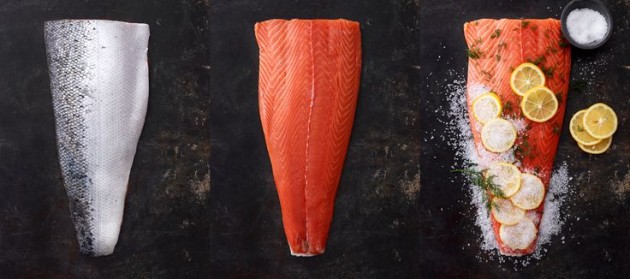
Whilst rules are made to be broken, when you are paying good money it’s nice to get a few tips and pointers to help you enjoy just what it is you are spending your hard earned dollars on. Nobody wants to waste their own money, no one wants to be disappointed and the number one reason we do not try something new is fear, fear of the unknown, fear of failure. The reasons we do overcome our fears and try new things are because we are programmed to want new things and new experiences. We desire new things and when we are given enough endorsements about a new experience or product, then we will overcome our fear of failure or disappointment and take the risk, we will give it a try.
Our dreams, our fantasies are necessarily unrealistic, they have to be because the moment they become our reality we can no longer desire them. In order to desire something, to want something, it must be absent and it is that absence that allows us to desire it. It is the desire, the fantasy that excites us. As Pascal notes, It’s not the “it” that we want, it’s the fantasy of “it”. This is what he means when he says “We are only truly happy when we dream about some future happiness”.
We are programmed to want new things because we actually enjoy the wanting more than we enjoy the having, because we can create a fantasy of what it is like to have something which is disconnected from the reality of having it. In a modern commercial world, we replace emotional needs with material wants, leaving us unfulfilled and moving on to the next desire and the next fantasy from the very moment we get what it is, (we think) we want. This is where terms like enjoying the journey more than the destination and enjoying the thrill of the hunt more than the kill come into play.
Jacques Lacan suggests that because of this human phenomenon, living by our own wants can never make us truly happy; we cannot measure the enjoyment of our life by those things we have attained or the sheer number of desires we have fulfilled. He urges us to seek a deeper meaning in life based on ideas and ideals.
We may have a favourite restaurant where we order the same favourite dish or dishes and we may follow a certain wine region or wine brand, or grape variety when it comes to our wine choices, this is where terms like comfort food and wines that are ‘safe bets’ can come into play. We do this because it is safe but, eventually we will get bored with this as other desires and fantasies -even on this seemingly insignificant level- begin to take hold of our thinking, our imagination. We may read a bit of marketing propaganda or hear something from a friend; this maybe gets us thinking that perhaps we should be looking to try something else. If the staff in your favourite restaurant are not able to introduce us to a new experience, in such a way as to have us overcome our fears and go for it, if they do not understand our culinary desires, fantasies and needs enough to make smart recommendations, then we may soon find ourselves looking for another restaurant and the next dining fantasy may have already begun.
Alternatively, we may have a favourite restaurant where we trust the chef so implicitly and the sommelier that we see their restaurant as having some sort of safety net, we are happy to go there and place ourselves into their hands and let them feed us any dishes and wines they may want to share with us and guide us into new territory. Because we already know they are good at what they do and we trust them enough, we feel we are experiencing something that even if we don’t fully enjoy it, we at least feel as though we perhaps should.
However, this too will only ultimately lead to disappointment, as the restaurant fails at the impossible task of matching our fantasies and fulfilling our desires over a sustained period. This is because once they have fulfilled our desires enough we seek even bigger and broader fantasies and develop desires they simply can no longer fulfill. This is one of the reasons only the very best restaurants, (in any category you care to put it) survive for many years on end and why new restaurants are constantly being opened, it is also why many chefs and restaurateurs are constantly reinventing themselves, in order to appeal to a new set of desires.
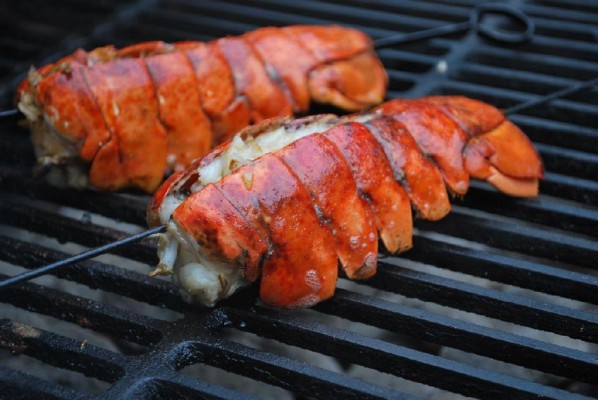
So what can we take from this philosophy, we can understand that it is both necessary and enjoyable to seek new experiences and that there will be failures, when we experience failures we may fall back on the comfort of things know we can trust and consider dependable, until eventually we have the courage and desire to again be adventurous and try new things.
Wine & Seafood
“As I ate the oysters with their strong taste of the sea and their faint metallic taste that the cold white wine washed away, leaving only the sea taste and the succulent texture, and as I drank their cold liquid from each shell and washed it down with the crisp taste of the wine, I lost the empty feeling and began to be happy and to make plans.”
― Ernest Hemingway, A Moveable Feast
Rules are indeed made to be broken and I have always considered it beyond my brief to tell people exactly what they should be eating and drinking; instead, what I try to do is identify exceptional examples of certain cuisines, dishes, wines, styles or combinations of the two and explain what makes them exceptional I my opinion and therefore worth experiencing.
When it comes to pairing food and wine in general, I have a number of criteria I need to posit, consider it a number of questions that I like to be able to answer in the affirmative before I am happy to make a recommendation. However, it is also important to remember that wine and food pairing is completely subjective and what I am happy to recommend and even the criteria I use, may not be to everyone’s liking and that is perfectly ok with me, because the more we all experiment, the more we all discover.
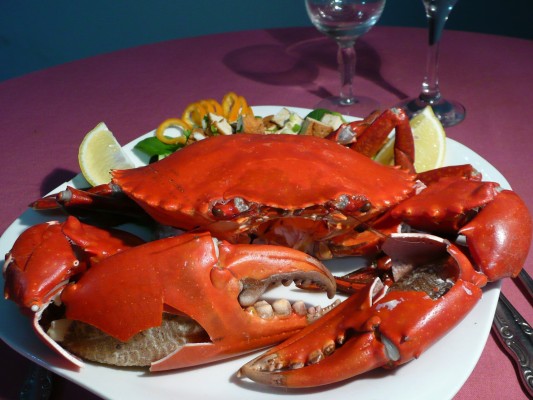
Body Image
The body of the wine and the body of the dish are important for me when pairing, is the dish heavy or light or somewhere in between and therefore is the wine of a similar weight. Pairing light, elegant wines to heavy, strongly flavoured dishes can overwhelm the flavours of the wines and leave it tasting a little like a glass of water. Conversely, pairing a big, full bodied and perhaps tannic wine with a lighter, more delicately flavoured dish can leave the food tasting bland and boring. Wherever possible I consider like for like light to medium bodied wines with lighter dishes and medium to fuller bodied wines with heavier, fuller flavoured dishes. Here the quest is balance, a harmony between the food and the wine and not to have one dominating the other.
Complimentary flavours
Just as chefs pair proteins and vegetables with certain sauces, purees, gravies and marinades because they have flavours that compliment, so too do wines possess flavours that can complement proteins and other ingredients in the same way. The little hint of mint in a cool climate Cabernet with some lamb, the peppery spice in a Shiraz or Syrah with beefsteak, the citrus character in a Riesling with white fleshed fish, the smokiness in a barrel matured Chardonnay with Salmon are a few that readily come to mind.
Contrasting Textures
As well as weight and flavour we consider other ‘in-mouth’ sensations when it comes to pairing food and wine, things like the texture of the wine can play a significant role in potential pairings.
Wines with good mineral or chalky acidity or wines with course, drying tannins can contrast with richly flavoured foods, foods that are a little oily or fatty. They work well because they cut through these oils and fats and clean up the palate, revitalizing it and enabling the diner to enjoy each mouthful afresh and without getting coated in oils and fatigued with excessive fats. Conversely, dishes that are bitter and astringent can benefit from a touch of sweetness and glycerol. It is worth remembering that bitterness or astringency in food tends to enhance bitterness or tannins in wine and this can make an unpleasant combination. Dishes with high levels of acidity need to be paired with wines that have a higher level of acidity or acidic intensity or it will taste like it is lacking in structure and when looking to match sweet wines with sweet desserts, the wine needs to be sweeter than the dish or it will taste bland.
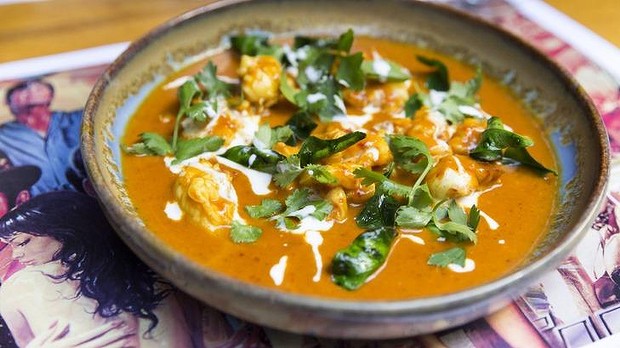
The Spice Question
Firstly, it helps to understand a little about peppers, what makes hot peppers hot is an alkaloid called capsaicin and related compounds known as capsaicinoids. When capsaicinoids bind to pain receptor neurons on the tongue they immediately send messages, (probably along the lines of: ouch this is bloody hot) to the brain. Now it will also help to learn that Capsaicin is insoluble in water -which is why drinking icy water provides little relief from the burn beyond the first few precious gulps, once the mouth warms up the burn is back.
In some regions of the sub-continent they serve yoghurt drinks to go with rich fiery curries; capsaicin is fat soluble and yoghurt shakes are cold, high in lactic acidity (to stimulate saliva flow) and have some sweetness (which is also proven to ameliorate the burn), this makes a yogurt shake a very effective remedy.
However, if knocking over a few bottles of vintage yoghurt at dinner is not your idea of a fine repast, good news is at hand. Capsaicin is also soluble in alcohol and fruit sweetness, (natural fruit sugars) such as those found in wine is very effective at ameliorating mouth-burn. Acidity is also effective in wiping out some of those burning sensations because of its promotion of saliva flow.
It is important to remember that Alcohol, once it reaches certain concentrations, (usually once you get up over about 12.5% Alcohol to Volume) gives off a warm feeling in the mouth and we certainly don’t want to be attempting to wash away heat with more heat!
That is why I look to low-alcohol wines to match with hot and spicy dishes, wines from cooler climates with alcohol levels under or up to about 12%.
Regardless of heat intensity I always like to try to match the weight or body of the wine to the weight of the dish. Put simply, for lighter dishes I look to lighter bodied wines and for heavier dishes I look to fuller bodied wines.
Matching wine to hot, spicy fuller bodied dishes should not mean higher in alcohol, oak character and tannin, I find tannin and oak are amplified with hot spicy foods and are generally an altogether unpleasant combination. In my opinion, big spicy, alcoholic reds brimming with woody/ oak characters and aggressive tannins render the dish awful and your palate wanting to sue you for malpractice.
When matching wines to lighter bodied, spicy dishes such as Thai salads and soups, fish, hot and sour dishes or vegetarian curries, my preferred wine of choice is a cool-climate, low alcohol Riesling, usually from Germany or Alsace France, but it may be from Australia or New Zealand; the higher the heat intensity the sweeter I tend to like it. Pinot Gris or pinot Grigio can also work well as can Sauvignon Blanc and a light gewürztraminer. A juicy Viognier, (but again watch the alcohol level) can work well with curried chicken dishes, whilst with dishes of extreme heat intensity a slightly spritzy Moscato tends to work very well.
When it comes to fuller flavoured dishes and red wines I tend to be a little more controversial. I look for rich, juicy, flavourful reds with good acidity, low alcohol and barely perceptible tannins. The wine that works perfectly well for me is a good, rich, cool-climate, New World pinot noir or a riper French Burgundy. Now whilst these wines are generally categorized as medium bodied, the rich primary fruit flavours and good acidity see them stand up to the most vigorous red curry beef or Szechuan peppered pork. A Cote du Rhone or Cool Climate Syrah/shiraz will also do nicely; just watch the tannins and alcohol levels.
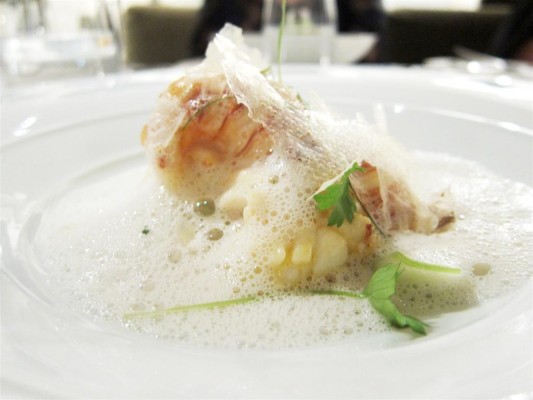
Pairing seafood and wine
When pairing wines with seafood there is literally an ocean of possibilities, pairings and enjoyment out waiting to be discovered. Fish is generally lighter than many land based proteins, especially red meats of course.
There are a number of things to consider when paring wine with fish, some fish is lighter flavoured and some is more strongly flavoured, there are white fleshed fish and pink or red fleshed fish, there are fatty, oily fish species and there are flaky, drier fleshed types of fish. Crustaceans can have rich, almost sweet fleshy flavours and shell fish can be very salty and mineral like in the acidity.
With lighter flavoured seafood it is sometime important to know the herbs, spices sauces being used and consider these flavours and characteristics in the pairing deliberations. If the overwhelming flavour of a dish is going to be citrus and herb for example, then you may wish to select a wine that copes with or pairs well to these components.
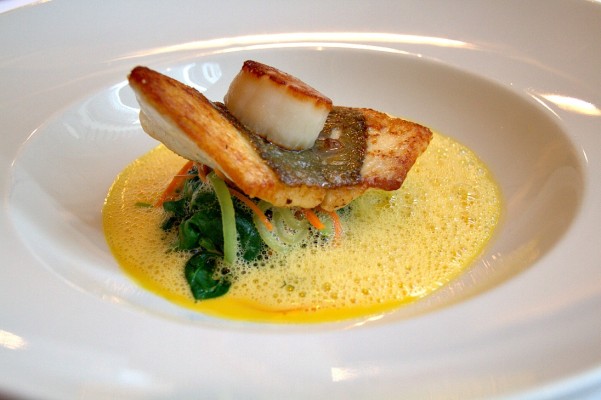
Respect for the Classics
Oysters Natural
Classic: Oysters have that wonderful creamy texture and all that minerality, sea salt character that pairs beautifully with subtly flavoured wines with high levels of bright malic acidity, Champagne is the ultimate classic pairing and Chablis the classic still wine pairing. It is no mean feat to get over the top of the briny characters of a fresh, raw oyster but these wines have the acidity to match them and do it magnificently well.
Alternative: More a less popular classic than an alternative, Muscadet Sur Lie is stunning wine with oysters natural, if you hold a good glass of Muscadet Sur Lie up to your ear you can almost hear the ocean and the neutral flavours, slightly leesy character and long and strong wash of minerals make it the perfect accompaniment.
Cured or Raw Salmon
Classic: One of the traditional ways to prepare salmon is to smoke it, one of the classic characters of White Burgundy, Chardonnay and many New World Chardonnays is to have those toasty, smoky barrel characters, the richness and body to go with this strongly flavoured fish and enough acidity to cope with the high levels of amino acids in the fish.
Alternative: If it has to be red then Pinot Noir is a light bodied, fruity red wine with minimal tannins and good acidity, it has the body and flavour intensity to match the Salmon without overwhelming it.
Steamed fish
Cantonese Steamed Fish is a fresh and delicately flavoured dish with some ginger, soy and a little spice. It is a dish that is really focused on the freshness and the texture of the fish and is incredibly elegant in flavour intensity; the classic pairing is a subtle wine with good but refined and restrained acidity and flavours, so they do not overpower the dish. Pinot Blanc form Alsace is a wonderful variety for this type of dish as is a dry, subtle Australian Riesling from the Clare or Eden valleys.
Alternative: A fruity and crisp Sauvignon Blanc from the New World might be a little overwhelming but can cope with plenty of ginger and spice and can work well with this dish if restraint is not really your thing.
Pepper Crab
Classic Pairing, for the sweet flesh and fiery spice of a pepper of chili crab an Alsace Riesling is a classic pairing, all that juicy ripe fruit flavour and saliva promoting citrus acidity complimenting the flavours and coping well with the spices, a divine pairing.
Alternative: I have tried this several times and it works well, some wine tasters love nothing more than to match a medium bodied, spicy Syrah from the Rhone valley with a spicy crab, as long as the tannins and alcohol are not too high then it works for me too.
Curry Prawns
Classic: Gewurztraminer from Alsace is a wonderful pairing for a Malabar prawn curry, handling the spices well with its sweetness and acidity and have complimentary, complex fruit flavours. A fruity Sauvignon Blanc or Alsace Riesling also works well here with matching flavour intensity and combating spice with acidity and sweetness.
Alternative: In Kerala, Tamil Nadu and all up and down the Malabar Coast they match sweet yoghurt drinks and dips with spicy curries to combat the heat component, the bubbles in Sparkling wines also work well to transport heat away from the pain receptors on the tongue. Try an off dry Prosecco or frizzante Moscato if you don’t mind a little sweetness with your main.
Tuna sashimi
Classic: Champagne Blanc de Noir is a classic pairing with raw tuna, the sparkling mousse refreshing the palate and contrasting the fatty richness whilst the pinot noir fruit has the flavour intensity to go with this boldly flavoured fish. Rose can also work well as can a fruity Pinot Noir table wine of red is your fancy.
Alternative: a smoky, intensely chalky Pouilly Fume can have a revitalizing effect on the palate between morsels of fatty tuna with its laser like acidity and slightly passionfruit, tropical fruit flavours enveloped in that fume gunsmoke character.
Grilled Squid
Classic: Alberino has the flavour profile, flavour intensity, body and structure to go well with squid, which has a strong textural element to it as well as the charry flavours off the grill. The wine style is like a squeeze of fresh lemon juice with a hint of apricot and white peach supported by zesty, vibrant acidity.
Alternative: A dry rose can work very well with the Maillard Reaction and vulcanization of the flesh whilst having the acidity to contrast the texture of the dish and subtle enough flavours so as to not overwhelm it.
These are a few dishes and wine pairing suggestions that are well worth trying to make your own conclusion and then have fun coming up with your own classics and alternatives, most importantly enjoy the experience and repeat often.
